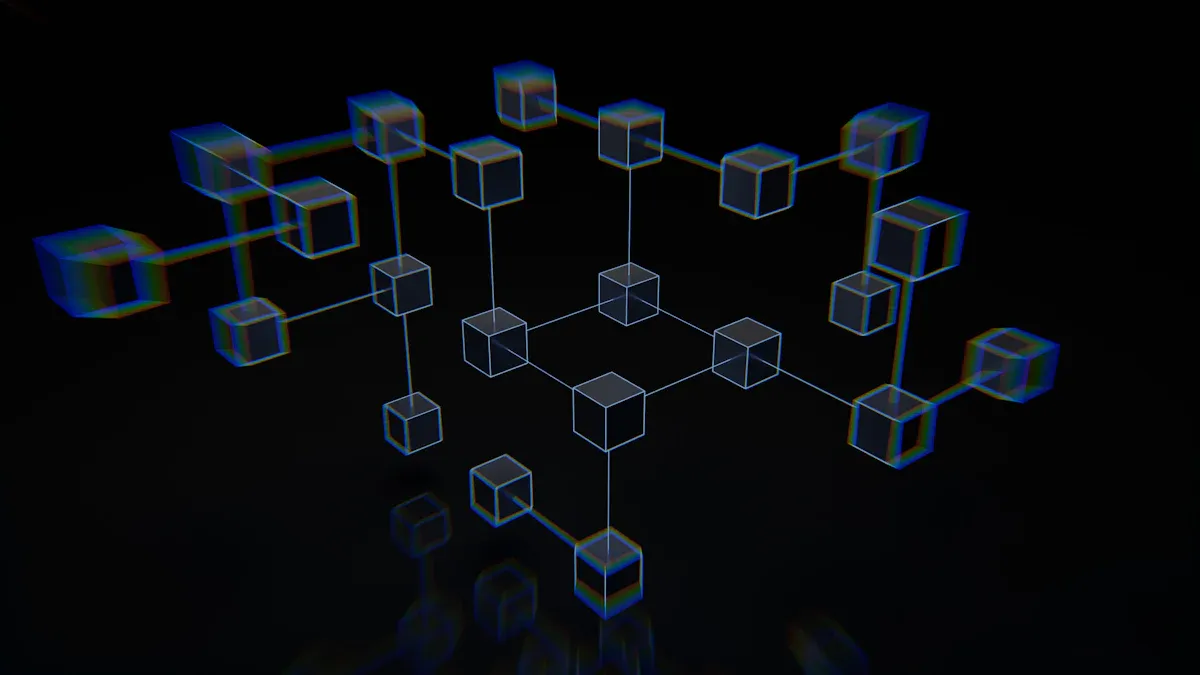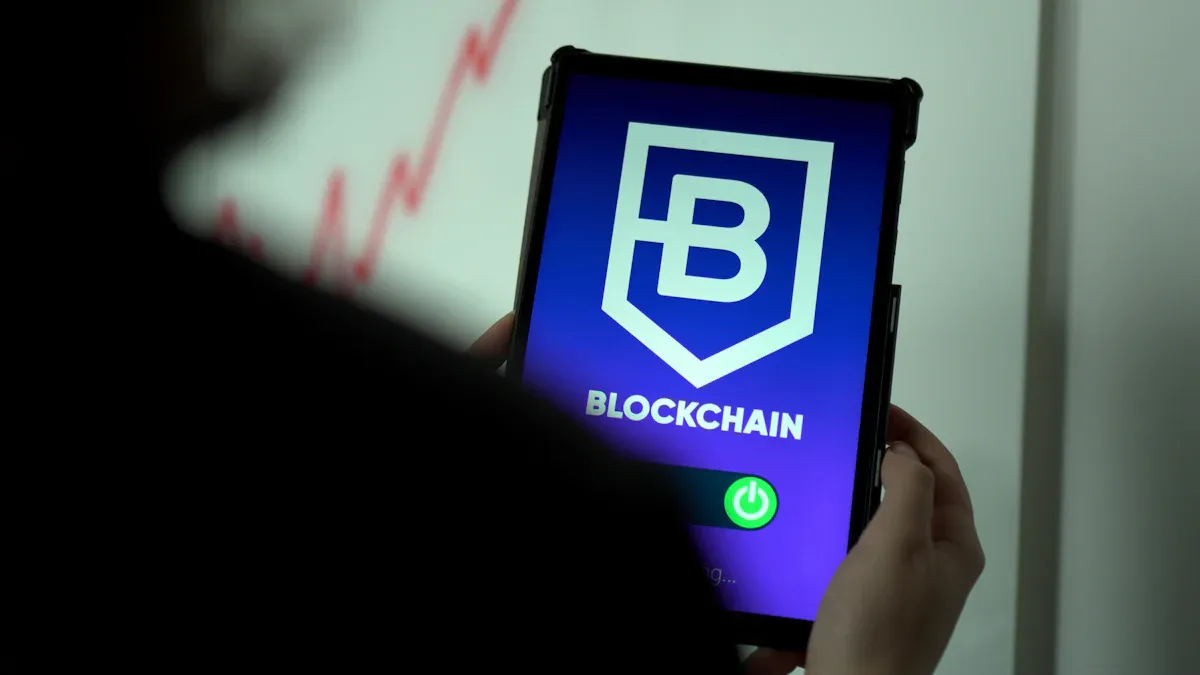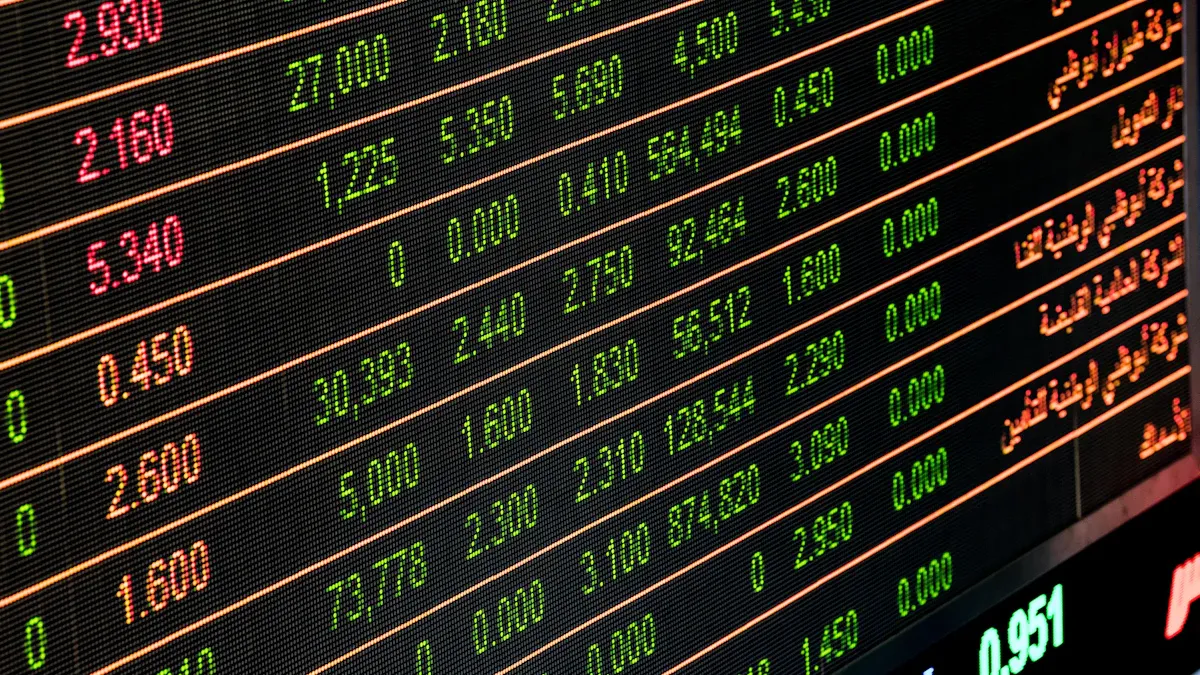Image Source: unsplash
I have witnessed blockchain in business redefine how companies operate globally. Its ability to enhance traceability and auditability in supply chain finance optimizes financial processes. Asset management has also transformed, with blockchain automating compliance and governance, cutting costs and risks. Decentralized lending platforms now promote financial inclusion by enabling global access to credit while reducing fraud. These innovations make blockchain in business: future disruptions and investment opportunities indispensable.
Key Takeaways
- Blockchain improves safety and clarity in business work. It changes industries like banking, health, and shipping.
- Decentralized Finance (DeFi) lowers costs and makes payments faster. It changes how people and companies handle money.
- Putting money into blockchain tools like cryptocurrencies and NFTs can help grow and spread investments.
Understanding Blockchain Technology
Core Principles: Decentralization, Transparency, and Immutability
I believe the core principles of blockchain—decentralization, transparency, and immutability—are what make it revolutionary. Decentralization eliminates the need for a central authority. Instead, it distributes control across a network of participants. Transparency ensures that all transactions are visible on a public ledger, fostering trust among users. Immutability guarantees that once data is recorded, it cannot be altered. This combination creates a system that is both secure and trustworthy, unlike traditional centralized systems.
Key Components: Distributed Ledger, Smart Contracts, and Consensus Mechanisms
Blockchain operates through several key components that work seamlessly together:
- Nodes: These are individual computers in the network. They store copies of the blockchain and validate transactions.
- Distributed Ledger: This ledger records all transactions securely and is shared across the network.
- Smart Contracts: These are self-executing contracts with terms written in code. They automate processes without intermediaries.
- Consensus Mechanisms: Algorithms like Proof of Work and Proof of Stake ensure that all participants agree on the validity of transactions.
Each component plays a vital role in maintaining the integrity and functionality of the blockchain network.
Blockchain vs. Traditional Systems
Blockchain systems differ significantly from traditional centralized systems. The table below highlights these differences:
| Aspect | Blockchain Systems | Traditional Centralized Systems |
|---|---|---|
| Decentralization | Data is distributed across multiple nodes. | Data is stored in a central server. |
| Data Integrity | Immutability ensures tamper-proof records. | Trust relies on a central authority for data accuracy. |
| Performance | Slower transaction speeds due to consensus requirements. | Optimized for high transaction volumes and quick access. |
| Scalability | Can be hampered by the need for consensus. | Efficiently scales to handle large data volumes. |
| Trust Model | Eliminates need for a central trusted authority. | Trust is based on the database administrator. |
| Security | Enhanced fault tolerance through decentralization. | Relies on centralized access control and permissions. |
These differences highlight why blockchain is a game-changer for industries. It offers a level of security, transparency, and decentralization that traditional systems cannot match.
Disruptions Blockchain Brings to Industries

Image Source: unsplash
Finance: Decentralized Finance (DeFi) and Cross-Border Payments
Blockchain has revolutionized finance, particularly through Decentralized Finance (DeFi) and cross-border payments. DeFi eliminates intermediaries, enabling direct transactions between participants. Smart contracts automate processes, reducing transaction costs and settlement times. For example:
- Reduction of transaction costs compared to traditional banking systems.
- Near-instant transaction speeds, with settlements completed in minutes rather than days.
- Tokenization of assets, allowing fractional ownership and increased liquidity.
These innovations make financial services more accessible and efficient, transforming how businesses and individuals manage money.
Supply Chain: Transparency, Traceability, and Cost Reduction
Blockchain enhances transparency and traceability in supply chain management. I’ve seen how tamper-evident shared ledgers record transaction data across multiple stakeholders, fostering trust among parties. Key benefits include:
- Improved tracking of product provenance and compliance.
- Risk mitigation through accurate and immutable records.
- Cost reduction by streamlining processes and eliminating inefficiencies.
This technology ensures that every step of the supply chain is visible, creating a more reliable and efficient system.
Healthcare: Secure Data Management and Interoperability
Blockchain in healthcare addresses critical challenges in secure data management and interoperability. By storing patient data on blockchain, healthcare providers ensure security and accuracy. Patients maintain control over access to their records, fostering trust. Additionally, interoperability allows providers to access comprehensive medical histories, improving patient care. Blockchain’s ability to facilitate secure sharing among providers, payers, and researchers has transformed healthcare operations.
Retail: Decentralized Marketplaces and E-Commerce Innovations
Retail has embraced blockchain through decentralized marketplaces and e-commerce innovations. These marketplaces connect buyers and sellers directly, eliminating intermediaries and reducing transaction costs. Blockchain also facilitates secure payments, loyalty programs, and product authenticity verification. For cross-border e-commerce, blockchain enables real-time transactions, reducing costs associated with currency conversion and processing times. These advancements enhance transparency and minimize fraud, creating a more trustworthy retail ecosystem.
Real-World Examples of Blockchain Disruptions
Blockchain’s impact spans multiple industries. Some notable examples include:
- Voting: Democracy Earth and Follow My Vote are enhancing voter registration and counting.
- Government Operations: Dubai aims to store all government documents on blockchain for efficiency.
- Healthcare: Companies like Gem and Tierion are improving secure data sharing for medical records.
- Energy Management: TransactiveGrid enables peer-to-peer energy trading.
- Retail: OpenBazaar connects buyers and sellers directly, eliminating middlemen.
- Real Estate: Ubitquity offers blockchain solutions for property record-keeping.
These examples demonstrate blockchain’s versatility and its ability to disrupt traditional systems across industries.
Benefits and Challenges of Blockchain in Business
Benefits: Efficiency, Security, and Operational Transparency
Blockchain technology offers businesses several advantages that enhance their operations. I’ve observed how its strong security infrastructure makes hacking nearly impossible. The immutable ledger prevents fraud and unauthorized access, ensuring data integrity. Blockchain also automates processes, reducing manual tasks and improving operational efficiency.
Transparency is another key benefit. The consensus mechanism records all transactions, fostering trust among stakeholders. Businesses can reduce data reconciliation costs and eliminate intermediaries, leading to significant cost savings. Additionally, faster transaction handling becomes possible by removing manual processes and third-party involvement. These benefits make blockchain a powerful tool for businesses aiming to streamline operations and build trust.
Challenges: Scalability, Energy Use, and Regulatory Issues
Despite its advantages, blockchain faces challenges that hinder widespread adoption. Scalability remains a critical issue. Blockchain networks often struggle to process a high volume of transactions simultaneously, which limits their use in mainstream applications. Regulatory uncertainty also poses a significant barrier. Different countries have varying approaches to blockchain, creating a fragmented market that discourages investment and innovation.
Environmental concerns further complicate blockchain adoption. High energy consumption, especially in proof-of-work systems, raises sustainability questions. However, initiatives like the EU MiCA Regulation and PwC’s Blockchain Sustainability Framework aim to address these concerns. Blockchain can also track carbon emissions and manage carbon credit transactions, promoting eco-friendly practices.
Addressing Common Misconceptions About Blockchain
Many misconceptions about blockchain persist. Some believe it is synonymous with cryptocurrencies, but blockchain has applications far beyond digital currencies. Others think blockchain is entirely anonymous. In reality, it provides pseudonymity, where transactions are traceable but not directly linked to personal identities. Educating businesses about these nuances is crucial for broader adoption.
Investment Opportunities in Blockchain
Cryptocurrencies: Bitcoin, Ethereum, and Emerging Altcoins
Cryptocurrencies remain one of the most prominent investment opportunities in blockchain. I’ve observed how Bitcoin and Ethereum dominate the market due to their established networks and widespread adoption. Bitcoin serves as a store of value, often referred to as "digital gold," while Ethereum powers decentralized applications through its smart contract functionality. Emerging altcoins, such as Solana and Cardano, offer unique features like faster transaction speeds and lower fees, attracting investors seeking diversification. These digital assets provide opportunities for both long-term growth and short-term trading, making them a cornerstone of blockchain investments.
NFTs: Digital Assets and Their Expanding Market
The NFT market has experienced explosive growth, driven by rising demand for digital art and collectibles. Investors view NFTs as a new asset class capable of delivering high yields and acting as a hedge against inflation. Businesses have also embraced NFTs to enhance customer engagement and loyalty. For instance, brands like Adidas and Gap have successfully integrated NFTs into their marketing strategies, creating additional revenue streams. Advancements in blockchain technology continue to fuel this expansion, enabling innovative applications and attracting more participants to the market.
Blockchain Startups: Innovative Business Models
Blockchain startups are at the forefront of innovation, introducing groundbreaking business models that reshape industries. Some notable examples include:
- Blockchain as a Service (BaaS): Companies can leverage third-party blockchain infrastructure without significant upfront investment.
- Token Economy: Utility tokens grant access to platform features, often funded through Initial Coin Offerings (ICOs).
- Peer-to-Peer Models: These eliminate intermediaries, enhancing efficiency and reducing costs.
- Decentralized Autonomous Organizations (DAOs): Governed by smart contracts, DAOs enable transparent and decentralized decision-making.
- Professional Blockchain Services: These include consulting and project management, making blockchain accessible to non-developers.
While investing in these startups can yield substantial returns, it also carries risks. The high failure rate of new ventures underscores the importance of thorough research and risk assessment.
Traditional Companies Adopting Blockchain: Tech and Finance Leaders
Established companies in tech and finance are increasingly adopting blockchain to enhance their operations. I’ve seen how giants like IBM and Microsoft offer blockchain solutions for supply chain management and data security. Financial institutions, including JPMorgan Chase, leverage blockchain for faster cross-border payments and fraud prevention. These companies demonstrate how integrating blockchain can drive innovation and efficiency, making them attractive options for investors seeking exposure to blockchain without directly investing in cryptocurrencies or startups.
Future Trends in Blockchain Technology

Image Source: pexels
Interoperability: Connecting Blockchain Networks
Interoperability is becoming a cornerstone of blockchain innovation. I’ve observed how advancements like chain abstraction simplify cross-chain interactions, enabling seamless transactions without the need to manage multiple wallets. Cross-chain liquidity aggregation, as seen in projects like UniswapX, optimizes asset swaps across networks. Modular interoperability frameworks now allow customizable cross-chain messaging, enhancing flexibility.
Several platforms are leading this charge:
- Polkadot connects multiple blockchains through its relay chain, fostering a unified ecosystem.
- Cosmos uses the Inter-Blockchain Communication (IBC) protocol to securely transfer data between blockchains.
- Chainlink offers unique solutions for cross-chain interoperability, further bridging the gap between networks.
These innovations are paving the way for a more interconnected blockchain landscape, where networks can collaborate rather than compete.
DeFi Evolution: The Next Phase of Decentralized Finance
Decentralized Finance (DeFi) continues to evolve, driven by emerging trends. I’ve noticed how artificial intelligence is being integrated into DeFi platforms to enhance risk management and trading strategies. Cross-chain interoperability is also enabling seamless transactions across different blockchains, expanding DeFi’s reach.
Sustainable finance initiatives are gaining traction, aligning DeFi with global ESG standards. Tokenization of real-world assets is another significant trend, offering fractional ownership and broader investment opportunities. With the DeFi market projected to grow from $26,170 million in 2024 to $37,040 million by 2028, these advancements signal a robust future for decentralized finance.
Tokenization: Real-World Assets on the Blockchain
Tokenization is revolutionizing how real-world assets are represented on the blockchain. I’ve seen how this process enables fractional ownership, allowing multiple individuals to own a single asset. It also enhances accessibility, making it easier for people to invest regardless of their financial situation.
Tokenized assets offer several advantages:
- Increased liquidity through easier trading.
- Greater transparency, as blockchain ensures all information is publicly accessible.
- Reduced transaction costs by eliminating intermediaries.
- Faster transaction speeds, often occurring in real time.
This innovation is not just about convenience; it’s about creating a more inclusive and efficient financial system.
Predictions for Blockchain’s Role in the Next Decade
The next decade will see blockchain technology reshape industries far beyond finance. I expect the global blockchain market to grow from $27.84 billion in 2024 to $825.93 billion by 2032. Concepts like Web3, NFTs, and the Metaverse will gain prominence, driving this growth.
Blockchain will also transform data analysis and consulting. Accurate transaction records will improve forecasting and insights, enabling businesses to make better decisions. As these trends unfold, blockchain will solidify its role as a foundational technology across multiple sectors.
Blockchain has the power to revolutionize industries and reshape investment strategies. I’ve seen its potential to enhance security, streamline transactions, and increase transparency. By democratizing access to investments and driving innovation, blockchain creates opportunities for businesses and investors alike. Engaging proactively with this technology ensures a competitive edge in the evolving digital economy.
🌟 Now is the time to embrace blockchain’s transformative potential and capitalize on its vast opportunities.
FAQ
What industries benefit the most from blockchain technology?
I’ve seen blockchain transform industries like finance, healthcare, supply chain, and retail. Its transparency, security, and efficiency make it invaluable for these sectors.
How does blockchain ensure data security?
Blockchain secures data through cryptographic hashing and decentralization. I’ve observed how its immutable ledger prevents unauthorized changes, ensuring trust and reliability in sensitive transactions.
Is blockchain technology environmentally sustainable?
Blockchain’s energy use depends on its consensus mechanism. Proof-of-Stake systems consume less energy. I believe ongoing innovations will make blockchain more eco-friendly over time.
💡 Tip: Look for blockchain projects prioritizing sustainability to align with eco-conscious goals.




